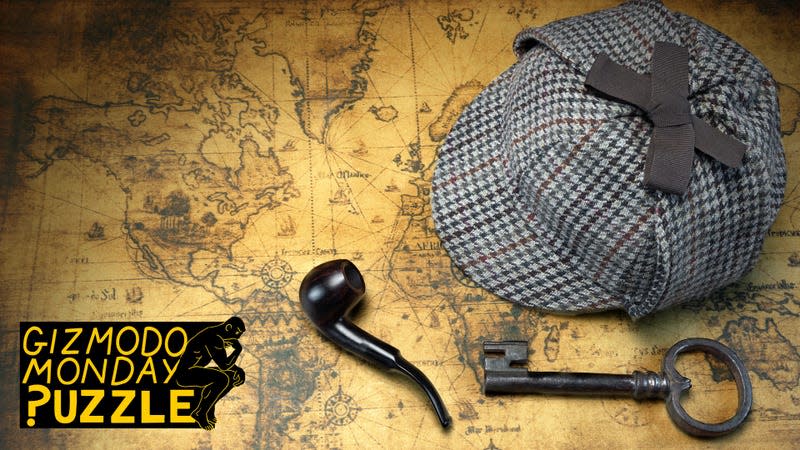Gizmodo Monday Puzzle: Help Sherlock Solve These Whodunits

- Oops!Something went wrong.Please try again later.
Name the ultimate puzzler from fiction. If you didn’t say Sherlock Holmes, then I need to read what you’re reading. In many depictions, Holmes seems to care about nothing other than the puzzles his cases pose. Beyond the twisty plots and endearing characters, Arthur Conan Doyle’s stories and the subsequent screen adaptations excel at clever mechanisms and deductions. This week you’ll slip into Sherlock’s deerstalker and solve two whodunits. These are a little more open to interpretation than our typical puzzles here, but that’s the nature of detective work. Both have intended solutions—the simpler the better. Read carefully, gather clues, and crack the case. The game is afoot.
Did you miss last week’s puzzle? Check it out here, and find its solution at the bottom of today’s article. Be careful not to read too far ahead if you haven’t solved last week’s yet!
Puzzle #35: Whodunits
1. It was a bright Tuesday afternoon, and Sherlock and Watson approached the apartment building as the coroners hauled away the body. The Chief of Police, Henry Meanswell, approached the men and said: “I know you boys love a crime scene, but I’m afraid your services won’t be needed here. This is an open-and-shut case of suicide.”
“Do you mind indulging us with what you know took place here today?” replied Sherlock.
Meanswell glanced at his watch and sighed. “A man named Diddy Jump was found dead on the front lawn of his apartment building. It appears he jumped out of the window of his studio apartment. His landlord, a sweet old lady named Agatha, found him. She explained to us that Diddy’s wife recently left him and he’s had trouble coping—drinking to excess and causing a ruckus in the building. Poor lady seems shaken up by the whole ordeal.”
“Did you inspect his apartment?”
“Yep, Agatha used her master key to let us in about 20 minutes ago, and it was like a pit of despair in there. Pitch black, beer bottles everywhere, and a stale stench. As soon as we flicked on the light, we saw the suicide note on the bed. It said that he couldn’t continue on his path of self-destruction and he wanted to end it all. Very sad, really.”
“Sad indeed, I suspect we have foul play on our hands.”
Why does Sherlock suspect a murder?
2. [This one was inspired by a post on puzzling.stackexchange by user Puzzlees]
Sherlock didn’t flinch when he saw Mrs. Howe’s body dangling from her dining room rafters.
“This one’s gotta be a suicide,” pled Chief of Police, Henry Meanswell. “The only reason I haven’t already booked it is because of my mishap at last week’s crime scene. Sorry to call you here so late, but I figured I should let you take a look first.”
Sherlock inspected the noose around Mrs. Howe’s neck. “She’s wearing a wedding band. It’s always the husband.”
Meanswell had an eager retort, as though he had practiced: “That was my first thought too. In fact, her kids and neighbors report that they’ve had extreme marital trouble and Mr. Howe has been violent in the past. However, he has an airtight alibi.”
“Seldom such a thing,” smirked Sherlock.
“Mr. Howe works at an automotive factory an hour and a half drive away. Security footage and multiple eyewitnesses confirm he was at work all day and he clocked out at 5:30 pm. Our forensics team analyzed the rope burns around the victim’s neck and used new high quality instruments to verify that Mrs. Howe died by asphyxiation at exactly 6:00 pm. Even if her husband raced at top speeds, there’s no way he could have made it here in time. Unless you think he trapped her in a noose and set up some contraption to drop her while he was far away? Or maybe he hired a hitman?”
“He didn’t need a contraption nor a hitman. Bring Mr. Howe in for questioning.”
Why doesn’t Sherlock view Mr. Howe’s alibi as exonerating?
I’ll be back next Monday with the answer and a new puzzle. Do you know a cool puzzle that you think should be featured here? Message me on X @JackPMurtagh or email me at gizmodopuzzle@gmail.com
Solution to puzzle #34: Fool’s Golden Ticket
Could you prove that Wonka’s winning chocolate bars from last week’s puzzle were pure imagination? Shout-out to Enfy, who was the only person to submit a correct answer. To the rest of you: You get nothing! You lose! Good day, sir!
In a 3x7 grid colored with two colors, there will always be a rectangle whose corners are all the same color. To argue this, note that every column of three chocolate units falls into at least one of the following categories:
The first and second units are red
The first and third units are red
The second and third units are red
The first and second units are blue
The first and third units are blue
The second and third units are blue
A column can have more than one of these characteristics. For example, if a column is all red, then it will satisfy conditions 1, 2, and 3. The important point is that every column falls into at least one of these six categories, because every column must have a repeated color and the above list exhausts all possible locations of the repeated colors.
Since we have seven columns, one of these six categories must repeat, and that will form a rectangle whose corners are the same color. The image below shows a 3x6 area containing each of the six categories once (and contains no rectangle with monochromatic corners). Notice that no matter how we color the seventh column, it will repeat one of these categories and force a rectangle.


